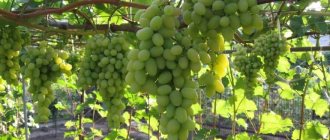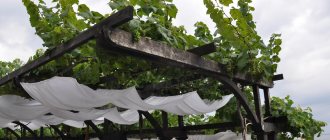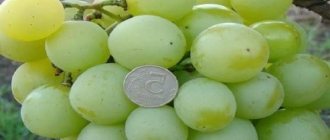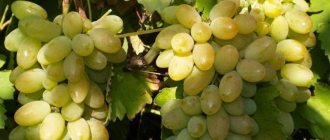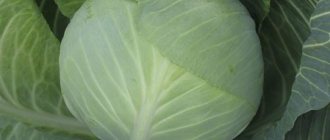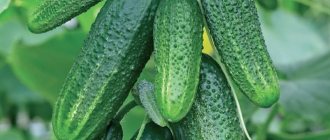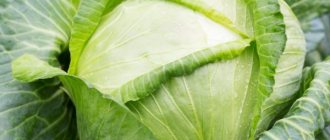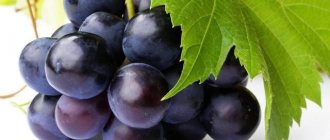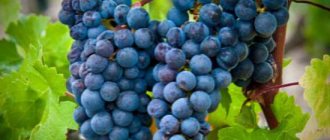Description of the variety
The name “Pleven resistant” was obtained due to the use of the variety “Pleven” as one of the parent forms, which was largely improved by Bulgarian breeders. The second parent plant when obtaining the “Phenomenon” variety is the famous “Vilar Blanc” grape, thanks to which a high level of stability of the new hybrid form was obtained.
The Phenomenon grape variety belongs to the table category and is rarely used for technical purposes. Variety from the selection of NIIViV in Plevna. The hybrid form is widely zoned, which allows the cultivation of grapes of this variety in many regions. The growing season lasts on average 117 days. The flowers are bisexual.
With sufficient care, grape bushes grow above average height and belong to the category of early ripening. The clusters are formed quite large, with an average weight of 450 g . The shape of fully formed grape clusters is cylindrical-conical, with moderate density.
The berries are smooth, oblong, amber-yellow in color, fairly large in size, about 3x2 cm, weighing from 5 to 7 g, with a strong but edible skin. The pulp of the ripe berry is fleshy and juicy. The taste is good. The tasting score is very high. There is a pleasant, refreshing and harmonious taste. A good level of sugar accumulation does not decrease even in conditions of heavy and frequent rainfall. The maximum acidity of the wort is 7 g/l, and the percentage of sugars is 21%.
No peas are observed. Full ripening occurs in the last ten days of August. The harvest can be stored on grape bushes for a long time.
Agrobiological characteristics
The bushes are powerful, vigorous and fast growing. The leaves are large, rounded with a slightly elongated middle blade, slightly dissected, five-lobed. The lateral notches are barely outlined or very shallow. The upper side of the leaf blade is dark green, shiny and smooth, usually flat, but there are also slightly curved ones. The bottom of the leaf is covered with sparse cobwebby pubescence, with bristles along the veins. The petiole recess is open, narrow, vaulted with a flat bottom. Augustine's flowers are bisexual; there are no problems with pollination under normal weather conditions.
The grape clusters are large, up to 20 cm long and up to 15 cm wide, with an average weight of 400-800 grams. Conical in shape, moderately dense. The comb is of medium length, the stems of the berries are short and strong. The berries themselves are large in size (on average 27x18 mm), weighing 5-7 grams, oval or elongated oval, white, and in the sun an amber-yellow color. Covered with a thin layer of prune plaque. The light translucence of the berries in the light makes the clusters especially attractive. In the rays of the sun they seem to glow from within. The pulp is dense, juicy and fleshy, with a simple but very harmonious taste. Medium-thick skin, edible. The large seeds in the berries spoil the overall picture somewhat, but the overall tasting rating, despite this annoying fact, remains high.
The clusters can remain on the bushes for a long time after ripening, however, it must be taken into account that the variety is susceptible to attack by the bunch budworm, and therefore measures are required to protect against this pest. The grapes are practically not damaged by wasps. In addition, it is worth keeping in mind the possibility of cracking of Augustine berries due to excessive soil moisture or sudden changes in soil moisture, which is why it is undesirable to keep the ripened crop on the vine for a long time during seasons with unfavorable weather conditions. In such cases, it is better to store it already assembled in cool, dry places.
The harvest is intended primarily for fresh consumption, but at the same time it makes excellent juices, compotes, and jam. Thanks to the large, pleasant-looking, literally “pourable” berries, the harvest of this variety is of interest and demand on the market, has excellent transportability and is quite well stored, provided that it is collected in a timely, careful manner and is not damaged by pests. Only when transporting overripe bunches of grapes over long distances is a slight shedding of the berries possible.
The variety is early ripening. To ripen the crop, 115−120 days of growing season and a total of 2400−2500°C active temperatures are required. Thanks to this, it manages to ripen even in the Ryazan and Kaluga regions, not to mention the more southern territories. Augustine's frost resistance is increased (-24°C), but in relatively northern regions it will still have to be grown in a cover crop. The yield is very high; during the state variety testing, Phenomenon showed results of up to 184 c/ha, or an average of 8-10 kilograms of grapes per bush. Some plants also showed much better performance. The percentage of fruitful shoots in the hybrid is high - up to 85%, while the number of bunches per fruitful shoot is average (0.8−1.2). The sugar content of berry juice during variety testing in different years ranged from 17.1 to 17.5 g/100 ml, titratable acidity was 6.5−9.4 g/cubic dm. The average tasting score for fresh berries over a five-year period is 8.2.
Advantages and disadvantages
A significant part of the variety’s advantages is due to the qualitative characteristics of the parent pair used in breeding work:
- the hybrid form is very productive;
- shoots are characterized by high-quality ripening;
- rooting at a high level;
- fairly high frost resistance of -25° C;
- excellent marketability of ripe grape clusters;
- complex resistance to damage by major fungal diseases;
- The variety is characterized by high transportability.
The most noticeable disadvantages in growing include:
- cracking of berries during a long rainy period;
- bursting berries are not only affected by rot, but also become attractive to wasps;
- berries picked at the wrong time and overripe fall off on their own;
- possible damage by bunch budworm;
- The berries of this hybrid form have several fairly large seeds.
- If transportation is too long, some of the berries spontaneously fall off the grape bunch.
Characteristics of grapes
The crop variety grown in different regions is slightly different in description. But there are also common features:
- growth period is about 117 days;
- the bunches do not wrinkle or crumble during transportation;
- have a high degree of rooting - up to 90%;
- Harvest in mid-August.
Taste qualities are not lost for about a month after harvest. It has a sweet and sour taste and juicy berries, so juices and compotes are often made from it. Refers to white grape varieties that have a large amount of vitamins A, B, K, PP and microelements.
Landing rules
To grow “Phenomenon” grapes in your home vineyard, you can use:
- planting varietal own-rooted or grafted seedlings;
- cuttings grafted onto rootstocks with a significant supply of perennial wood;
- obtaining a new vine through tapping.
Planting should be carried out in accordance with the method used. The location should have maximum sunlight and be protected from draft winds.
Basic requirements for landing:
- the distance between grape bushes in a row should be at least 1.5 m, and between rows - at least 3 m;
- the depth and width of the pre-prepared planting hole should be about 0.8 m;
- the soil mixture with which it is planned to fill the planting hole must be not only fertile, but also light;
- The main criteria for a quality seedling are a well-developed and healthy root system, as well as the presence of undamaged shoots.
The significant growth force of this variety requires the use of tying to a support, which will allow the planted grapevine to be directed vertically.
How to grow grapes Phenomenon
During the hot season, we all love to enjoy delicious, cool grapes. Bulgarian breeders pleased us with a delicious variety of these berries - Augustine or Pleven. Its more common name is Phenomenon. This product is a hybrid of the Pleven and Vilar Blanc varieties.
A very tasty, sweet, juicy elongated berry with a yellowish stone and a loose skin. The juiciness of Pleven is very high, which is why dried fruits and juices are often produced from it. The clusters of this grape are large and cone-shaped. It is ready for harvest in mid-August.
The juiciness of Pleven is very high, which is why dried fruits and juices are often produced from it.
The big advantage of this variety is its stability. It tolerates our harsh and changeable climate well, but the southern and central parts of the country are more suitable for it. “Phenomenon” can withstand frost down to -24 degrees. The plant is vigorous and bears fruit abundantly.
Many gardeners grow "Phenomenon" as an arbor or as an ornamental plant. This variety has a shallow root system and small but tall bushes. The foliage of the grapes has a light, not cloying aroma, but it does not attract wasps, so the integrity of the berries is preserved. It is ideal for lovers of a slightly tart aftertaste.
So, let’s summarize the characteristics of “Pleven”: high yield, frost resistance, beauty. To these should be added ease of care and high survival rate, but more on that later.
- 1 The “Augustine” phenomenon
- 2 Now about planting and care
- 3 Now about watering
The Augustine phenomenon
“Phenomenon” is classified as a table variety
“Phenomenon” is classified as a table variety. The leaves are round, entire with elongated contours, the flowers are bisexual. Their pollination is not affected by weather. There is no pea production (small berries due to poor pollination). Due to their high frost resistance, grape vines do not need to be hidden for the winter.
Experienced winemakers and gardeners point out the other side of Augustine’s unpretentiousness : “You don’t have to worry if you didn’t manage to harvest the grapes in a timely manner. It's not scary.
Ripe Phenomenon clusters can hang on the vine for up to three weeks from the beginning of ripening, without losing their marketability and excellent taste.” (With)
“Pleven” is a moisture-loving grape with a yield of 140 centners per hectare (about 60 kg per bush), which in itself is very advantageous. It is also true that the weight of one brush is about 500 g (one berry is approximately 8 g), for which sellers are very fond of this variety.
How did I grow strawberries in an apartment? Everything is very simple! Now you don't have to wait for summer. You need to take a homemade berry and... Read more... https://www.cpagettigeneral2.com/rbtz Money will come from nowhere... The legendary Swami Dashi shocked with his find... You need to say... Read more... https://www.mycpagetti3.com/rcjx I beg you, do not remove papillomas! I beg you, do not remove papillomas! To make them disappear, add 3 drops to a glass of water... Read more... https://cpagetti2.com/q8pV/sub1/sub2/sub3/sub4/sub5
Now about planting and care
The growing season of “Phenomena” is 117 days. It is better to start planting it in the spring, but you can also plant it in the fall. Spring shoots adapt better to conditions, which means they take root faster. But in the spring you will need to moisten the soil quite often.
Land preparation takes place 10 days before planting. It is carried out like this: for each hole, mix 2 buckets of compost with soil, pour it into the hole, and add soil. Then the seedlings are placed there up to the neck of the rhizomes. Watering should be plentiful.
The hole for the seedling should be 80–90 cm. After planting, a support is driven in near the hole, which is necessary for the vertical growth of the vine. The area where “Phenomenon” will grow should be on the sunniest side, but in a place protected from draft winds.
The distance between bushes is preferably at least one and a half meters, and between rows at least three.
And now about leaving. Although this variety is known for its disease resistance, preventive spraying should not be neglected. They must be carried out strictly during the flowering period.
When forming a bush, a multi-armed fan shape is recommended. With this choice, it is necessary to trim the shoots by only 12 eyes, no more. Feeding the plant is also important.
Humus or compost with phosphate-potassium additives is suitable for this.
Now about watering
"Augustine" needs to be watered abundantly
To reap a tasty and plentiful harvest, “Augustine” needs to be watered abundantly. If this rule is not followed, the grapes will wither. The trusses may fall off and the berries will become small. Although this is not typical for this plant, anything can happen.
In addition, if there is insufficient watering, the roots will grow in search of moisture. If, on the contrary, you flood the bush, this is fraught with other consequences: leaching of minerals from the soil, rotting and death of the grapes. Seedlings are watered once a week, and an already established bush is irrigated once every two weeks.
Closer to harvest (late July, early August), watering should be stopped. This will help the quality of ripening of the vines. The most difficult period in watering is the growing season, when the buds open and when the grapes fade. You should not water the bush during this period. Excess water may cause the color to fade.
Here are some simple tips for an inexperienced winegrower:
- dig a small ditch around the bush, water should only be poured into it;
- it is necessary to pour about 50 liters per square meter of soil (if there is a lot of sand in the ground, increase the volume by 1.5 times).
Drawing conclusions
So, “Phenomenon” deservedly takes the lead among other varieties. Easy to care for, frost-resistant, disease-resistant. These are not all the advantages of this type. The high yield and excellent taste of “Augustine” pleasantly pleases winegrowers in many regions. In conclusion, we note that it is not for nothing that these grapes are so praised.
The yield and unpretentiousness of the variety is surprising. It is profitable for sale not only because of the abundance of berries on the cluster, but also because of the level of sugar content. It is 20%, which is perfect for preschool children and for people with dietary needs or diseases.
“Phenomenon” will be a wonderful decoration for a garden plot with a pleasant taste.
Baba Nina about Russia: “Thunder will strike in October 2021 and money will fall from the sky...
Read the article »> https://cpagetti2.com/THLk/sub1/sub2/sub3/sub4/sub5 Ophthalmologists are shocked! Clear eagle vision will return in 5 days if you use a cheap... https://cpagetti2.com/QgqV/sub1/sub2/sub3/sub4/sub5 Parasites will come out, papillomas will fall off if you add simple... https://cpagetti2.com /q8pV/sub1/sub2/sub3/sub4/sub5 If sugar is above 4.5 mol/liter, immediately start eating raw in the morning... https://cpagetti2.com/GgqV/sub1/sub2/sub3/sub4/sub5 Like at 63 years old look 37? and Just make it a habit at night... https://cpagetti2.com/TgqV/sub1/sub2/sub3/sub4/sub5 Tamara Globa: Remember! Money always comes in abundance if you keep a small amount in the house... https://www.mycpagetti3.com/rcjx Write it down! How I earned 50 thousand rubles selling strawberries and wild strawberries... https://www.cpagettigeneral2.com/rbtz
Source: https://vinogradmoy.ru/vyrashchivanie/fenomen.html
Features of care
To achieve proper development of the grapevine and obtain stable yields, it is necessary to apply the following agrotechnical techniques:
- Carrying out periodic watering, the frequency and volume of which depend on weather conditions;
- mulching the soil around the grape bushes to maintain soil moisture;
- fertilizing using compost or humus supplemented with phosphate-potassium fertilizers;
- carrying out annual pruning with shortening the shoots by 6-12 buds, which depends on the type of formation of the grape bushes;
- Preference should be given to the multi-arm fan formation of grapes of this variety.
Despite the declared resistance, it is recommended to carry out timely preventive spraying. The optimal period for carrying out protective measures is represented by the flowering phase.
The load on each grape bush can vary from 35 to 40 buds. It is advisable to ration green shoots and grape clusters. Weak shoots must be removed.
We also invite you to familiarize yourself with the characteristics of the “Nizina” grape variety.
Diseases and pests
Fungal diseases:
- Mild. Appears as oily traces on the leaves. At different stages, the spots change color and become red. The disease causes rotting and drying of shoots and leaves.
- White, black and gray rot. They appear as a coating on the berries, which dry out over time, rot and fall off.
- Powdery mildew. A sign of oidium is a smoky white coating on the shoots and cracked, deformed berries.
- Anthracnose. A spot disease that damages fruits and branches. Brown spots.
Untimely treatment of diseases will lead to the death of the entire plant and its root system.
Pests:
- phylloxera;
- spider or felt mite;
- leafworms;
- wood borer;
- marble Khrushchev
Insects harm crops. To combat them and diseases, chemicals and organic matter are used.
Disease and pest control
To get rid of most diseases, bushes are sprayed with fungicides in the spring:
- "Topaz";
- "Skor";
- "Tiovit";
- "Jet";
- "Byleth."
For prevention, use 15 g of Fundazol, 40 drops of Ecosil and 2 ml of Topaz per bucket of water. Against black, white and gray rot, spray with a solution for which 20 g of benleit is mixed with 30 g of topsin. Also, against white and gray rot, the vines are treated with Bayleton, Baytan and Atem S. Against mildies, choose “Skor” and 2% Bordeaux solution.
The butterfly and caterpillars are destroyed by spraying with Decis, Proclaim, Marshall or Insegar. Anti-mite, Omite, Sunmite, and Taurus are suitable against spider mites. All chemicals are diluted in water according to the instructions. When spraying, you should protect your eyes and skin with special glasses and a suit.
For prevention, wood ash is sprinkled on the soil and leaves. To prevent diseases and pest attacks, proper pruning, proper watering and fertilizer are required.
Reviews from gardeners
Based on reviews from many gardeners who grow the hybrid form “Phenomenon”, we can conclude that medium pruning of the grapevine should be done for fruiting. However, the high level of fruitfulness of the eyes at the shoot base allows the use of short pruning. An overloaded vine ripens a little later.
Basically, reviews about the “Phenomenon” variety are positive and characterize this grape as a really very good and marketable variety with pollination acceptable in all weather conditions. The vine always ripens before the mass ripening of the berries. This variety is practically disease-free and has the advantage of strong growth. The ripening time of the hybrid form is slightly affected by the load of the grape bush.
How to plant correctly?
Having decided to plant “Phenomenon” grapes on your plot, first select the optimal place for it. The plant needs to be provided with plenty of sunlight and good protection from drafts. For planting, choose only high-quality seedlings that do not have any damage and have well-developed roots.
To ensure good growth and development of the vine, seedlings need to be installed in holes about 80 cm deep, located at a distance of one and a half meters from each other. The free space between rows should be three meters. Pour the fertile mixture into the holes in advance, and after installing the seedling, water the plant well.
“Phenomenon” can be planted in the fall, but it is preferable to choose the spring so that the plant has more time to adapt. Be sure to install a support to keep the vine upright.
Berries
The description of the variety in various sources indicates that the grape fruits are sweet, sunny, and have excellent taste characteristics. Large shiny clusters of medium density and regular conical shape. The weight sometimes reaches 1000 g. The size of the bunch reaches 28x17 cm. Round berries with a slight blush on one side look like little suns. The pulp is tender, juicy, pleasant to the taste, with seeds that are separated from it and a skin that is not felt at all and is easily eaten along with the berry. The berries are not subject to peas, the weight of one berry is 7-10 grams, the size is 2.7x1.8 cm, the taste is noble, pleasant, refreshing.
The berries of the Phenomenon are slightly translucent in the sun
Regardless of weather conditions, the accumulation of sugar in berries is consistently high and equals 21 g/100 cubic cm, acidity is 7 g/dm cubic.
Due to its high sugar content and juiciness, the grape variety is ideal for the production of juice and wine. The wine is light, with a greenish tint and natural sugar. Good dry wines have a fresh fruity aroma, while sweet wines are well balanced with a pronounced sweetness.
The color attracts attention, round, white berries, with a soft light green tint, when fully ripe, with a tan and noticeable strings of white veins visible through the thin skin.
And finally, the dolma recipe
Wash the grape leaves and cut off the stems. Place in a wide bowl, pour boiling water over it, hold for 5 minutes. Remove with a slotted spoon and cool. Cooking minced meat. Boil the rice until half cooked. For the meat base I use chicken fillet and lean pork belly or shoulder. You can also use the classic version: pork plus beef. I add onions and garlic along with the meat. I combine it with rice. Salt and pepper to taste. I put a little minced meat on the edge of the grape leaf, bend the leaf on both sides and roll it into a roll. I place the resulting rolls tightly in a wide pan and fill them with the water left after blanching. To prevent the dolma from floating, I place a plate on top of it. After boiling, cook over low heat for 30–40 minutes.
Sauce for dolma. No one in my family is on a diet, so I prepare a sauce that is quite high in calories: I mix 100 grams of mayonnaise with 200 grams of 10–15% sour cream. I add a little salt. I add finely chopped garlic, a lot of cilantro, dill and basil to the mixture. Bon appetit, good health and good luck!
Subscribe to our newsletter to be the first to know about new articles and promotions!
The Augustine phenomenon
“Phenomenon” is classified as a table variety. The leaves are round, entire with elongated contours, the flowers are bisexual. Their pollination is not affected by weather. There is no pea production (small berries due to poor pollination). Due to their high frost resistance, grape vines do not need to be hidden for the winter. Experienced winemakers and gardeners point out the other side of Augustine’s unpretentiousness : “You don’t have to worry if you didn’t manage to harvest the grapes in a timely manner. It's not scary. Ripe Phenomenon clusters can hang on the vine for up to three weeks from the beginning of ripening, without losing their marketability and excellent taste.” (With)
Historical details of the appearance of the new product
The work on creating the Phenomenon variety belongs to Bulgarian breeders. This is where the second name came from - Pleven. The Phenomenon culture was obtained by crossing the Pleven and Vilar Blanc varieties.
Excellent qualities allowed the new product to successfully take root in our country. According to climatic conditions, the south and central parts of the country are most suitable for it. In other places, low temperatures, which are typical for the northern and northeastern regions, became a significant obstacle. But this does not prevent residents of even remote corners of Siberia from regularly seeing Pleven in stores.
The characteristics of the variety include:
- Excellent yield.
- Frost resistance.
- Unpretentiousness.
- High survival rate.
- Reliability.
Pleven is considered a table variety, and its remarkable qualities have made it very popular among gardeners and winegrowers. Unpretentiousness, excellent yield and reliability are perfect for beginners who are just gaining experience in the intricacies of the grape business.
Reproduction
Warning! Seedlings should be purchased from trusted nurseries.
Cuttings from annual shoots can be rooted or grafted onto a selected rootstock. This method is quite cheap and, if you have experience, simple.
You can sow grape seeds after two months of stratification. The best time for sowing in the middle zone is the first ten days of June.
If you already have one Phenomena bush and you want to propagate it, this can be easily done by digging up a side shoot in the spring. By next spring it will be ready for independent growing season.
Warning! Do not forget to pour a layer of drainage, for example, 10 cm thick crushed stone, onto the bottom of the hole.
When planting, bury a piece of small-diameter asbestos pipe next to the bush - it is convenient to feed grapes through it, provided that it is buried deep enough.
In the first year after planting, the bushes are not formed so that they grow enough shoots to overwinter.
Warning! Experienced winegrowers do not recommend pruning a grape bush in the spring unless absolutely necessary; the vine may simply bleed out its juice and die.
You should approach pruning grapes creatively, taking into account the characteristics of each bush.
To plant grapes, you need fertile, well-moistened soil that is illuminated throughout the day. When plantings are shaded, yields are significantly reduced and ripening time is delayed.
On a note! When planting seeds, a loss of genetic properties is observed.
- to quickly obtain a harvest, the most appropriate method is to plant a seedling at the age of 2 years;
- You can take cuttings from annual shoots, root them or graft them onto a rootstock;
- If you have an Augustine bush, you can bury a side shoot in the spring at a distance of 1.5-2 meters from the bush into prepared holes, tying the top to a support, and after a year it is ready for independent growing season.
Important! In the conditions of central Russia, spring planting is preferable - the seedling will get stronger over the summer and will survive the winter easier than if planted in the fall.
The seedling for planting must have a healthy, undamaged root system and a green top cut. A few days before planting, place the roots in water so that they are saturated with moisture.
The grape bush is fed with the help of heel and dew roots. To protect the roots from freezing, you need to follow the planting rules.
- prepare holes 80 cm deep at a distance of 1.5 m from each other;
- interval between rows – 3m;
- put drainage at the bottom, in a 10cm layer (crushed stone, brick chips, pebbles);
- add fertile soil (2 buckets), superphosphate and potassium salt (300g each) to each;
- sprinkle fertilizer with a layer of soil;
- leave the hole for some time for the soil to settle;
- when planting a seedling, the root collar should not be buried in the ground, but when planting a cutting, it is better to bury it so that the roots do not freeze in frosts;
- Water the plantings well and in the future, until the seedlings take root, water them once a week;
- mulch the soil around the plant;
- in the fall, pour humus 20 cm thick near each bush - insulation for the winter and fertilizing for the spring.
Graft
To carry out grafting, you need a cutting with at least two eyes and a rootstock with a supply of old wood. The cuttings need to be prepared for grafting by following the procedures:
- To retain moisture, apply paraffin to the upper cut of the cutting;
- cut off the lower part of the cutting on both sides to increase the area of contact with the rootstock;
- dip this cut in a root growth stimulator.
The rootstock also needs to be prepared in a certain way:
- trim the old vine, leaving a stump 10 cm high;
- process the cut until smooth;
- On the rootstock, in the middle, make a not very deep cut.
Once the cutting and rootstock are prepared, the cutting is placed in a cut on the rootstock, pulled together and, finally, the grafting site is coated with clay. More than one cutting can be grafted onto a wide rootstock.
- in the fall, when pruning, cuttings with 3-5 buds are cut from strong branches on which the bark is not woody;
- wrap the planting material in a damp cloth and put it in a cool basement for the winter;
- in early March, remove the cuttings and place them in water for 12-18 hours to saturate them with moisture;
- check each cutting by cutting from one edge - the cut should be light green (brown spots or a dark cut indicate that the cutting is unusable);
- soak the suitable material in a weak manganese solution for two hours, then the lower cut in a root growth stimulator for 3-4 hours;
- Before planting, they can be kept in water until roots and leaves appear, and then planted in prepared loose soil.
Spring cares for grapes
Around the end of April, I free the vines from shelter and untie them. I spray with any copper-containing preparation, for example, Ordan or Hom. For mature bushes I apply 0.5 cups of specialized fertilizer for grapes (Florovit) or any complex Spring-Summer fertilizer (for young bushes I reduce the dose by 2 times). I loosen it shallowly, mulch with compost (1 bucket), and sprinkle ash on top. This amount of food will last him at least until mid-summer. Although grapes grow a large leaf mass, they completely lose all resistance to diseases with an excess of fertilizers, especially mineral nitrogen. Again I cover the grapes with one layer of non-woven material. In the second half of May, I finally lift the grapes onto the trellis, distribute the shoots evenly and tie them up. I act very carefully so as not to damage the young shoots. At the end of May, when it already becomes clear which shoots and buds have overwintered and which have not, I carry out sanitary and formative pruning: I remove all the dried and excess vines left just in case, and immediately break out the unnecessary shoots at the bottom of the sleeves. Sometimes three shoots come out of a bud at once - I leave one, the strongest one. Next, I spray the bushes with the following solution: for 5 liters of water I take 0.5 ml (half an ampoule) of Zircon and 10 tablets of Alirin. I repeat this preventive treatment against diseases every two weeks until September.
